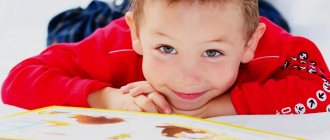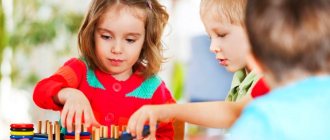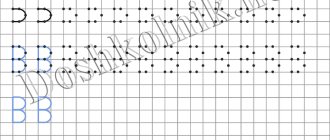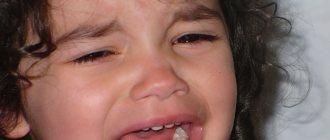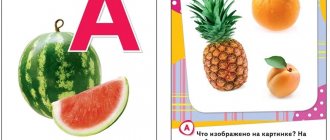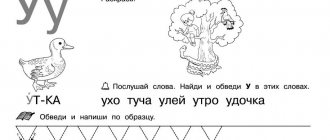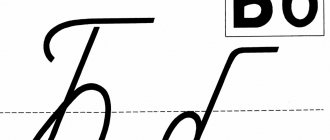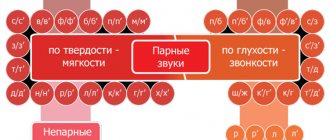Article:
Letters surround us everywhere.
The child sees them in books and magazines, on food packages, and in store windows. He can't help but wonder what it is. Over time, he begins to understand that adults can read, begins to copy his parents, learning a poem or fairy tale by heart, and pretending that he is reading a book. Experts recommend teaching a child to read shortly before school, since at an earlier age his brain is not yet ready to perceive such information. You can learn sounds with it, learn to distinguish them in spoken speech, and begin to master the alphabet. This preliterary period is very important, since thanks to it the child will be able to learn to read fluently and understand what he reads.
Content:
- Learning letters: where to start? Is your child ready to learn the alphabet?
- Advice from psychologists
- 3-4 years
- Game techniques
- A brief overview of modern primers
Electronic poster “Talking ABC”
The educational sound poster is a great addition to standard alphabet learning techniques.
It combines visual and audio perception, allowing you to learn the letters and sounds of the alphabet, as well as numbers from 1 to 33. The poster features several modes - song, riddle or task, which allows you to diversify the learning process.
The posters differ in sound and pronunciation principles. It is recommended to choose those where there is a pronunciation of letters as sounds.
Learning the alphabet is an important step in the life of every child, which will allow them to gain new knowledge and analyze it. It is worth treating this period with patience and helping your child learn through a playful approach and support.
Learning letters: where to start?
Photo source – www.freepik.com
Before teaching your child letters, you need to decide: 1) whether he is ready to learn, and 2) what goal you are pursuing. If the reason lies in the parents’ desire for the child to know as much as possible in order to show off to others, it is better to leave this idea. The young student himself must show an interest in knowledge and want to learn the alphabet. You need to concentrate on his desires and abilities.
If parents see that their child is inquisitive and shows interest in new knowledge, this is a signal that they can start learning letters. It is important to remember that any theory must be supported by practice. Having learned the letters, proceed to syllables, and then gradually move on to reading.
The main task of parents is to be patient and convey information in an accessible form, and also not to force the child to study if he does not want to. It is better to conduct classes in the form of a game.
You need to start training only if the child himself wants it, or if he will soon go to school. According to the requirements of educational institutions, when entering school, children must know the basics - letters, numbers. Without these basic skills, studying will be much more difficult.
Is your child ready to learn the alphabet?
To determine how ready the baby is, there are psychological tests. Parents are asked to answer yes or no to the following questions:
Development of cognition
- Does the child understand such judgments - right/left, much/little, big/small, low/high, near/far, under/above.
- Can understand simple situations in which it is necessary to divide objects according to classification. For example, identify a group of green and red objects.
- Is he able to think of the end of a fairy tale or story?
- Does he consistently fulfill three requests, without reminding his parents?
Basic knowledge
- Has the child ever been to a post office, a store, or a zoo? How broad his horizons are.
- Have you visited the library?
- Did his parents read fairy tales to him, starting from a very early age?
Speech development
- Is it easy for the child to name the objects that surround him?
- Is it easy to answer the questions asked?
- Is he able to tell the purpose of household things - a vacuum cleaner, an iron, a refrigerator.
- Can he determine the location of objects - on, under, inside, near.
- How clearly does he pronounce words?
- Can he conduct a dialogue?
Development of the emotional sphere
- Is the child having fun with friends and communicating with family?
- Can he adapt to new changes in his daily routine?
- Knows how to compete and cooperate with friends.
Communication level
- Can he share toys and communicate with other children?
- Knows how to listen to others and not interrupt.
Level of physical development
- Is the child diligent, is he able or not to sit quietly for a certain period of time?
- Plays with the ball, jumps, goes down and up the stairs.
- Gets enough sleep, has a good appetite, and knows how to extinguish emotional outbursts.
Development of visual abilities
- Can a child distinguish between similar and dissimilar and classify them into separate groups?
- Distinguishes short words and syllables with similar sounds - forest/weight, cat/year.
- Able to notice changes - if three pictures were shown at first, and then one was removed.
- He knows how to spell his name, what at least three letters from the alphabet look like.
- According to the instructions of an adult, he is able to lay out pictures on the table.
- Knows the order of reading words - from left to right.
- Folds the minimum number of puzzles - from 10.
Hearing development
- Rhymes words.
- Repeats words and numbers after adults.
- Understands that words that are similar in pronunciation have different sounds.
- Retells what he heard.
Interest in reading
- Enjoys looking at the pictures.
- Loves to listen to fairy tales.
- Interested in letters.
Thinking about learning the alphabet in preparation for school? Find out how many words per minute a preschooler and primary school child should read and for what “grade”.
If parents can answer affirmatively to at least 50% of the questions proposed, they can safely offer their child to study the alphabet.
Advice from psychologists
To learn the alphabet with your child, speech therapists and psychologists recommend following these tips:
- do not teach letters strictly in alphabetical order;
- do not learn all the letters mixed together;
- first learn vowels, then consonants;
- name the sound, not the spelling of the letter (incorrect - BE, DE, correct - B, D);
- consolidate what has been learned with practice - show how to write, give the child the opportunity to write with chalk, paints, or with his finger on the cereal.
A bit of "general theory"
First of all, it is important to understand that a little person’s speech develops in stages. Experienced parents probably remember that in the first months of life their baby chanted vowel sounds, then began to hum, pronouncing syllables with simple consonants, then came the first onomatopoeia (“am-am”, “av-av”) and the first words.
- Closer to one year, the child can say “mom,” “dad,” “baba,” “uncle,” “give,” and perhaps several other words. He also uses the “wrong” words (“kup-kup”, “bye-bye”).
- From one to two years old, the baby learns to formulate the first simple sentences (“I’ll have soup”, “Dad, give me”). If the syntactic structure of a sentence (subject - predicate) can be traced, no attention is yet paid to the purity of sounds: the child’s articulatory apparatus is not yet sufficiently formed for this. But the so-called “passive” vocabulary, which began in the first months, is being replenished by leaps and bounds: the child learns to understand new words, remembers their pronunciation and meaning, although he does not yet know how to pronounce them. Later they will turn into his active speech. Now he no longer just pronounces the “vocabulary set”, but listens to how he says these words and the sounds in them, and is able to evaluate whether it is correct or not.
- Around 3 years old, a child learns to repeat short poems, as well as construct complex sentences with the words “because”, “which”, “so that”. Most often, it is at this age that whistling sounds (S, Z, C) “ripe.” But even if they are still being replaced (for example, by the sound T), but the child’s intelligence is developing normally (he understands speech addressed to him, knows the names of his relatives, or that animals also have mothers and fathers) - there is no reason to worry.
- By the age of 4, the child should know general words (what are dishes, transport, toys, clothes). The pronunciation may not yet be very clear (hissing and P are the ones that suffer most often).
- At the age of 5, a child must correctly pronounce all sounds, since by this time the parts of the brain responsible for the development of speech have been sufficiently formed, and the speech apparatus has reached the required “condition” (provided that the child has been constantly trained: speech itself is not will come “out of nowhere”).
Methods for studying vowels/consonants
To teach your baby letters, you need to be patient. You should not demand too much, otherwise he will lose interest in knowledge.
First, talk about each vowel letter separately. For example, the letter A. Name it, show how it looks in writing, how to write it. Next, name the words in which it is present. Show pictures that depict objects, people and animals whose names contain the letter A. Next, invite the child to independently remember words that also contain this letter. You can consolidate the theory with practice - while walking, pay attention to store signs, together with your child, try to find a letter that is already familiar to him.
After the previous sound has been learned, you can proceed to the next one. To captivate the baby, it is recommended to purchase cards with letters, a board, cubes, bright pictures and books.
⠀
When vowels have been studied and reinforced in practice, you can begin to master consonants. First, introduce the child to the sound, then show him the letters. Learn the sound D, not the letter DE . Otherwise, he will experience disorientation in the process of combining syllables into words. The method of studying consonants does not differ from the method of vowels. It is important to practice as often as possible, to remember together words that contain the learned letter. Sequence of actions, repetition of learned material, patience - this is what will help parents.
Where to start learning the alphabet?
The child began to show interest in letters. There is no need to immediately load him with knowledge, cram the alphabet. Move little by little. The easiest way for children to remember is the first letter of their name. Explain to him what this letter is and what it is called. You can ask him to find this letter in the text. Gradually he will learn to highlight it and will pay attention to it. The first step has been taken.
Parents now trust various children's tablets, phones and other similar toys to educate their children. Remember that they are learning to pronounce letters, not sounds. Kids need to be taught sounds, so it will be easier for them to master reading.
A letter is a graphic representation of a sound, each has its own name. But learning to read knowing only the names of letters is very difficult. Imagine that a child will need to read the word “ball”. How will he do this? The way he was taught: “baael.” And all because he pronounces letters, not sounds.
It is better to start learning with sounds, pronouncing them with your child. Parents themselves should not confuse sounds and letters. Sound is what we hear. A bumblebee buzzes is a sound, a hammer knocks is also a sound. But we cannot get words from all sounds. If we clap our hands, the sound will appear, but the word will not.
You can create a word from special sounds called speech sounds. Make sure that the child does not confuse the letter and sound. Explain to him that a letter is an icon that can be seen in a book or drawn on paper. Letters can be seen with our eyes, and sounds we can hear.
How to learn the alphabet - adapt to the child’s age
3-4 years
To quickly teach a 3-4 year old child, you need to start with simple letters (those that are most often used in speech). After this, gradually move on to complex and rarer ones. This way he will remember the words better and faster.
You only need to learn one letter per lesson. You shouldn’t conduct “lessons” every day - it’s better to do it at intervals of two to three days.
Secure the result using cards, cut out letters from paper or fabric, sculpt from plasticine or dough. Each time before a new sound, repeat the material covered. At 3 years old, a child will be interested in listening to and learning a funny song or rhyme with the alphabet.
At this age, there is no need to force or rush the child. School is not soon yet, quick preparation for it is not required. Conduct classes only at the request of the baby.
It is important to consider the following points when teaching three-year-olds:
- do not expect your child to learn the alphabet quickly (be patient and devote time to studying regularly);
- do not exercise for more than 7 minutes a day;
- learn letters in pairs - A-Z, U-Y;
- do not proceed to study consonants without vowels;
- Remember that at this age imaginative thinking plays a big role, so you need to purchase bright books, toys and pictures.
It’s easier to conduct classes with a four-year-old. At this age, children have more developed processes of perception and analysis of abstract information. You can add puzzles, magnetic letters, cubes to the pictures, attract fairy tales, rhymes, stickers, posters. For better memorization, name the letters and write them immediately, encourage the child to draw them with a pen, pencil, or chalk.
Try an interesting and quite effective technique: forming letters from simple improvised means - buttons, sticks, sand.
You can learn the alphabet with a four-year-old child through the following games:
- cut out letters from paper, and then choose at random and name them;
- show pictures of animals, things, etc., and ask what letter the depicted object begins with;
- learn rhymes and songs with the studied sounds.
5-6 years
5-6 years is the most optimal age for teaching a child the alphabet, and as a result, reading. He must speak and pronounce sounds correctly. If you have difficulties with this, you should visit a speech therapist. At this age, activities cease to be purely playful in nature. The child needs to be told why he needs to know the alphabet. For example, say that now he will be able to read books on his own.
Advice to parents. Five-year-olds can be offered special educational books and notebooks. For example, you should take a closer look at game books with puzzles, mazes, crosswords and other interesting tasks.
⠀
Parents of preschoolers can purchase copybooks in which children will perform various educational tasks. A good option is “First words. Recipes for preschoolers. With tasks. 5-6 years” – publication authored by S.V. Petrenko. This manual is not overloaded with exercises; the words are given in enlarged form. Plus, after completing the task, the child is asked to independently evaluate his work (circle the sun with the appropriate rating) - this will allow the child to feel what it is like to be a schoolchild.
For training, you can use the methods of 4-year-olds (section above). But increase the study time (make the process longer), study every other day and be more persistent. You can also use educational cards and pictures. Assemble letters from puzzles and cut-out parts, sculpt and draw. At this age, a child will be interested in playing with a ball - throw him a ball and say any word, and let him throw the ball back and say the first letter of this word.
After learning vowels and consonants, show your five-year-old how to form syllables.
⠀
The educational material includes cards with syllables that make up words. Before you begin directly teaching your child to add syllables, it is recommended to select several games and exercises with letters. The adult shows the child two cards with letters: a vowel and a consonant, where one letter follows the other, while the parent or teacher pronounces how a syllable is formed from them. For example, the letter L runs towards the letter A, resulting in the syllable “l-l-l-a-a-a”.
An example of a game that helps a child learn syllables
To play you will need scissors, paper and pencils.
The point: the child is asked to draw a car or a house with a window. Make cuts along the side edges of the window. Prepare a paper tape, place the vowels on it: A, O, E, Y, U, I, E, Z (keep in mind that the width of the tape should fit into the cuts on the window). Then glue a transparent pocket - it will be located directly in front of the window (a piece of polyethylene is suitable for this purpose). In this pocket, place the consonant letter L, N, M one by one (choose the simplest letters), then insert a ribbon with moving vowels into the window, stretch it out, showing the child how to form syllables.
7 years
Preschoolers are taught letters using elements of classical classes - books, primers, alphabet, and copybooks. The child needs to be taught not only to pronounce sounds, but also to represent letters in writing. The purpose of the lessons is not only the alphabet, but also learning to organize your own time. The child learns to do homework according to a schedule, at the same time, devoting at least half an hour to completing the work.
After the child has learned the consonants, you can try to form syllables. For this purpose, you can use cubes, puzzles, or draw syllables on the board.
An electronic primer will be a useful acquisition. With its help, the activity turns into an exciting game. When choosing an alphabet book, make sure that the robot pronounces sounds, not letters. In addition, use special workbooks, and also ask your child to talk as much as possible - talk about the past day, retell fairy tales.
The future student will be interested in theoretical lessons in the form of educational cartoons. You can cut out letters and glue them in the form of appliqués.
When sending a child to first grade, a parent worries not only about the level of preparation of his child, but also about the health, safety, and adaptation of the young student to new conditions. To worry less about your child and respond to all problems in a timely manner, buy your student a children’s smart watch or install the “Where are my children” application from the AppStore and GooglePlay. This way you can always know where your child is, what route he is taking, and what is happening around him!
Letter Ш
In order for the letter Ш to be pronounced correctly, the speech apparatus must be well trained.
When pronouncing the letter Ш correctly, the tongue is positioned strictly symmetrically. The lips are always rounded, and the teeth are as close to each other as possible. In the middle of the wide tongue there is a warm stream of air, which can be easily felt with the palm of your hand near the mouth. Vocal cords are open.
It is often difficult for children to perform such actions with their tongue and lips. Therefore, there are various ways to pronounce the letter Sh.
Attention! None of the following pronunciations are correct. They all require adjustments.
- interdental pronunciation (the sound in this case is lisping, and the tongue is stuck between the teeth),
- pronouncing "in the nose"
- a way in which the tongue rests on the teeth, and the sound becomes similar to T,
- when there is a malocclusion, the sound is similar to F,
- sound reminiscent of S.
You can learn to pronounce the letter Ш at home. To do this, you need to perform exercises daily to establish breathing and train the muscles of the tongue and lips.
In addition, you must complete game tasks to consolidate the skills you have learned.
Articulatory gymnastics is performed daily, at the beginning of the lesson. It is important to stretch not only your tongue, but also your lips.
- Tongue exercises:
- “Hide the candy.” The child should keep his wide tongue on his lower lip. An adult places a small piece of marshmallow or marshmallow on its edge. The baby needs to hide a piece of sweetness by holding it with his tongue behind his upper teeth and sticking it to the roof of his mouth. The exercise is performed at a slow pace. The mouth should not open wider than 2 cm.
- "Football". You need to smile and put your wide tongue on your lower lip. Before this, you need to prepare a piece of cotton wool. The child should blow on the cotton wool, pronouncing the sound F. You need to roll it to the opposite end of the table. It is important to ensure that the sound is pronounced as F, not X - this will affect the width of the air stream. The cheeks should not puff out.
- "Harmonic". You need to smile, stick your tongue to the roof of your mouth, and, without letting go of your tongue, open and close your mouth. Worth imagining. that this is accordion fur. Each time you need to open your mouth wider and wider, and hold your tongue in position at the palate longer (from 3 to 10 counts). The sides of the tongue should not sag. The mouth and lips are always motionless.
- Lip exercises:
- "Tube". The child should stretch out his lips with a straw and silently pronounce the letter U.
- "Bunny." You need to smile, opening your upper and lower teeth. The upper and lower lips rise in turn. It is important to ensure that the teeth are closed and the lips return to their original position.
Games with the letter Ш
- Finish the phrase (or repeat it). It is worth preparing pictures in advance to help. For example:
Shu-shu-shu - Masha eats noodles. Shi-shi-shi - eat your porridge, kids. Sho-sho-sho - Pasha writes well.
- Game "Change the word." We need to change the word so that the sound “sh” appears in it. At first, you may need the help of an adult. But soon the child will be able to change words according to the model on his own.
Peas - peas, nut - nut, sparrow - sparrow, bread - bread, etc.
- Hiss like a snake, like a deflated balloon, etc.
- Songs, nursery rhymes, poems.
Letter Ш - Hissing, Sometimes-Rustling, Often-Rustling, Occasionally-Grindling.
The snake hisses, hisses, hisses, has been learning the alphabet for six months, the poor thing is already tired, and only knows the letter - Sh-Sh-She.
Shu-shu-shu - the mouse rustled, Shu-shu-shu - the reeds rustled, The nimble little woodpecker, Husking the sixth cone. What's that noise? Ears can hear, Someone is breathing louder, louder, Someone is waving higher, higher, Someone is whispering: “Hush, hush.”
Tongue twisters with the letter Sh
A good way to reinforce the learned skill of pronouncing the letter Sh in a fun way is to learn funny tongue twisters.
- The mouse sewed boots for the cat, and the cat sewed pants for the mouse.
- Shura sewed boots with an awl for a chinchilla in a hut.
- Our sail is sewn conscientiously, even a storm will not frighten us.
- The sperm whale does not like porridge; porridge makes him cough.
- Piggy Nyusha invited the mouse Masha to eat porridge. Masha the mouse brought Nyusha the pig a piece of pear.
- Pasha Sasha sews boots, and Sasha Pasha bakes pies.
- They sewed a shirt with pockets, sewed it, sewed it, altered it, sewed it up, but didn’t embroider it.
How to quickly learn the alphabet - the best proven methods
Photo source – www.freepik.com
It is impossible to force a child to learn the alphabet. This activity should bring him pleasure. We invite you to familiarize yourself with proven ways to get your child interested in learning letters.
Game techniques
Children learn material more easily through playful presentation. They will enjoy activities in the form of a game. What can you offer:
- to sculpt;
- paint;
- cut out letters;
- collect cut cards.
A useful learning option is sculpting. The process involves several sensory organs and develops fine motor skills. Prepare several small pieces of plasticine, twist them into long “worms” and fold them into letters, while simultaneously pronouncing the sounds with your child.
Coloring pages can be made in the form of pictures with letters. It is better to choose large sketches to make it easier for the child to color.
Paper cutting is also great for developing fine motor skills. But you shouldn’t ask your child to cut out the letters right away. It is better to cut the parts from them and then put them together in the form of a puzzle.
Positive emotions are of no small importance in the learning process. A good option is to bake cookies in the form of letters, put together letters from vegetables or fruits, and draw them on the surface of the pancake with condensed milk or jam.
Classical training
The basic option for learning the alphabet is to use educational cards. With the help of this didactic material, associations are consolidated and visual memory develops. If the child is tired, it is better to stop the lesson and start learning later, when he is in a good mood.
The classical teaching method involves the following options:
- learn basic vowels - A, O, U, I;
- proceed to the remaining vowels;
- after studying vowels, study simple consonants - L, M, N, B, P, G;
- go to sibilant consonants.
It is recommended to conduct lessons not only at home at the table, but also in nature, during walks.
Author's methods
There are many proprietary methods with which you can teach your child the alphabet. You don't need to combine them all. Stop at the most optimal option for you.
Polyakov's technique
The basis of the technique is the multiple pronunciation of groups of sounds with their replacement. The technique consists of five lessons:
- In the first lesson, pairs of letters A-Z are studied; O-Y.
- On the second, a pair of letters U-Y is added.
- In the third lesson, the letters A-Z are removed, but the pair I-Y is added.
- The fourth lesson involves adding the pair E-E, but excluding the pair O-E.
- In the fifth lesson - repetition and consolidation of the material.
The duration of the lesson is no more than 10 minutes. The interval between classes is two days. On other days, it is recommended to simply repeat the material covered.
This technique uses cards with letters.
Zaitsev cubes
With the help of cubes, you can start learning from the age of two. The process will become an exciting game.
Main principles of classes:
- provide information systematically;
- use visual images to visually perceive information;
- present material from the specific to the general.
The purpose of the technique is to teach not syllables, but warehouses - the consonance of consonants and vowels, consonants with a soft sound, vowels in the form of syllables.
Application of Doman cards
The technique helps to start early learning (it can be used by children from six months old). It is an image of objects on cards and words-inscriptions. Most often, in the form of themed sets.
All cards are arranged sequentially - from simple to complex. First come simple words, then phrases and sentences.
Games and exercises for home activities
How to teach your child letters at home? In addition to special aids, such as a primer, the alphabet, in psychological and pedagogical practice you can find many interesting tasks for consolidating knowledge about letters and sounds. Such collections will help parents organize home schooling competently and, most importantly, in an interesting way. There is no need to take on complex gaming tasks; the simplest games can become a fun learning tool for kids.
We are building an unusual house
A simple game exercise with cubes will help reinforce the names of the letters. An adult can purchase ready-made cubes with images of letters; together with your child, you can prepare homemade ones, for example, by painting ordinary wooden cubes. With their help we learn letters, for example:
- Let's build a ladder of letters that can sing (vowel sounds a, o, u, s, e);
- Let's build a house for the doll from cubes with different letters and teach them to call them d, o, m;
- Let's show the correct cube - the answer, for example, to riddles with the letter b:
I walk around in a fluffy fur coat, I live in a dense forest. In a hollow on an old oak tree I gnaw nuts (squirrel)
There are workers in the river, neither joiners nor carpenters, but they will build a dam - at least paint a picture (beavers)
- Let's find a cube where a stork is drawn (ask what the first letter is).
Parents' creativity can help make playing with blocks fun. Cubes with a certain letter can be placed everywhere: in the room, kitchen, hallway; on the closet, TV, table, windowsill, so that they constantly accompany the baby.
Where is the letter hidden?
An adult places one copy of the letters in different places in the room, and hangs the other in a visible place for comparison. Among them is a letter that the child needs to find. The game is played according to the “hot - cold” type. The player follows the adult’s instructions, for example: go straight, then turn left, take two steps, turn left again. The leader directs the movement using the words “cold, warmer, cold again, warm, hot.” On the way, the baby finds other letters and compares them with the one he is looking for. In addition to consolidating letters, spatial skills are developed.
Who can collect the letters faster?
It is advisable for several participants to play, so it is good if the whole family takes part in the game. Pictures with different images of the same letter are laid out on the court, and the players, at the leader’s signal, begin to collect them. It’s good to use funny rhymes, you can write your own, to create a positive mood, for example: “An arrow leads us to the letter b. Here is a birch tree, and here is a squirrel.” The one who collects the most images faster wins. There must be a student among the winners.
Bag with letters
We study letters with the children using the classic version of the “wonderful bag”. An adult prepares a beautiful bag, puts small objects in it, the name of which begins with the letter being studied, for example, “r”: pen, fish, strap, comb, daisy, robot. The child takes out the object and clearly pronounces the word. In the future, the game becomes more complicated because the letter being studied moves to the middle and end of the word.
What does the letter look like?
The game is played according to the type of associations (images that arise in the mind in response to a letter). Such tasks help children easily remember letters, without repeating them many times. Associations can be something like this: come up with an object that the letter looks like ( A is like the roof of a house, O is a steering wheel, a wheel, U is a twig fell from a tree, F is a bug, P is a collar). In this exercise it will be interesting to use rhymes that can be found in any textbook for preschoolers, for example:
B is like a trumpet that buzzes: “Boo-boo, boo-boo”!
Looks like B , no doubt, like pretzels, a bicycle.
the letter D , it’s sailing towards us like a boat.
The letter Z is just like a beetle, perched on a branch.
Educational online games
In addition to classical games and exercises, online games are actively used as one of the techniques in modern pedagogy. They can be successfully introduced into home activities. The main thing is to remember that the time spent at the computer should be limited for preschoolers to 10 to 15 minutes. Games must also correspond to the age of the children, level of knowledge and methodological requirements, for example, for children online - the game teaches them to correctly name letters, for older preschoolers - to remember the order of letters, form syllables, and look for missing letters in words. We learn letters with children using, for example, such games:
Talking alphabet for children
The talking alphabet works wonders! Press any letter and immediately get the word! In the game, the preschooler fixes the correct name of the letter and sees a picture that depicts an object for this letter. It is useful to practice this task for those children who are just beginning to recognize letters. You can make the game more difficult for older preschoolers by asking them to remember their order in the alphabet.
Connect the dots
Games like connecting dots with one line are intended for older preschoolers; they help remember the order of letters and distinguish between vowels and consonants. For example, one of these online games is “Little Foxes,” in which, using the correct combination of letters, a funny picture is created. The player, by pressing the keyboard buttons and connecting the dots, remembers the letters. If the task is completed correctly, the winter forest will be covered with snow. A more complex option: the preschooler is explained that vowel letters (singing) are colored red, consonants are colored blue (hard), and green (soft). The child must pronounce them with correct articulation.
Choosing an ABC book
To learn the alphabet, a child needs to be interested. To do this, it is important to choose the right primer:
- before purchasing, carefully examine the pages to see if everything is clear to you;
- choose hardcover editions with thick sheets and bright, large images;
- It’s good if copybooks and block letters are combined.
A brief overview of modern primers
- In first place, according to generally accepted opinion, is “Primer” by N.S. Zhukova. This manual is unique in that all the tasks in it are selected with an emphasis on speech therapy. First, the child is introduced to the sound, then to the word, and only then is the syllable introduced. The textbook does not have an entertaining component, as the author believes that this will distract the child from the learning process.
- In second place is “My Primer: a book for teaching preschoolers to read,” authored by N.V. Beggar. The essence of the author’s methodology is the unique order of learning letters. Acquaintance with letters takes place taking into account the age-related characteristics of the child’s speech apparatus, from simple sounds to more complex ones.
- Also worthy of attention is the Primer; a guide to teaching children to read” E.I. Sokolova. The author has extensive teaching experience; she has developed her own method of selecting words, which helps to increase the effectiveness of further teaching independent reading.
Preschool age is the best period for learning letters
Many parents with small children have a question: when is the best time to start learning the alphabet? There are several opinions on learning letters by preschoolers:
- According to many modern parents, it is necessary to teach a child to read as soon as he speaks. They begin to master original techniques and purchase special manuals. However, there is not always enough patience and knowledge to complete the training that has begun. Therefore, the task of parents is to organize home schooling in such a way that both adults and children can do it.
- According to psychologists, there is no need to rush to teach your child the alphabet. If a child is not ready to perceive educational material, he may develop a persistent reluctance to learn letters and subsequently read. After all, this is a rather difficult task, requiring mental tension, attention, and speech. Experts believe that the optimal age for learning letters is 4–5 years, when the child is psychologically ready to learn. At this age, interest in everything new and a desire to be like an adult are more evident. Adults should take advantage of this interest and desire to learn new things.
- According to teachers (authors of early learning to read N. Zaitsev, G. Doman, V. Voskobovich), you can teach your child the alphabet much earlier than preschool age, for example, at one to two years old, if the baby shows such a desire.
The main thing that parents need to remember is that teaching should be free of coercion. Important: parents need to understand why we teach letters with a small child. If a preschooler under 4-5 years old really wants to learn the alphabet, then his desire should be encouraged. And if this is a tribute to fashion and the parents’ desire to keep up with others, then there is no need to rush. It is better to focus on general intellectual preparation and development of the speech apparatus by reading books, composing creative stories, inventing fairy tales, memorizing poems and sayings. Then preparation for school in senior preschool age will take place without stress. The preschooler himself will strive to keep up with his peers, acquire new knowledge, and actively behave in home classes to learn the alphabet.
